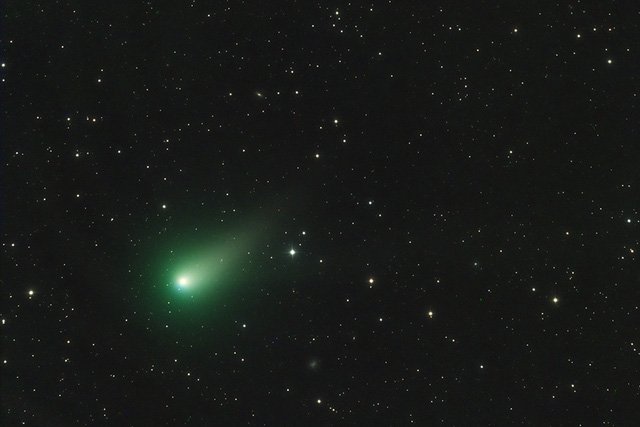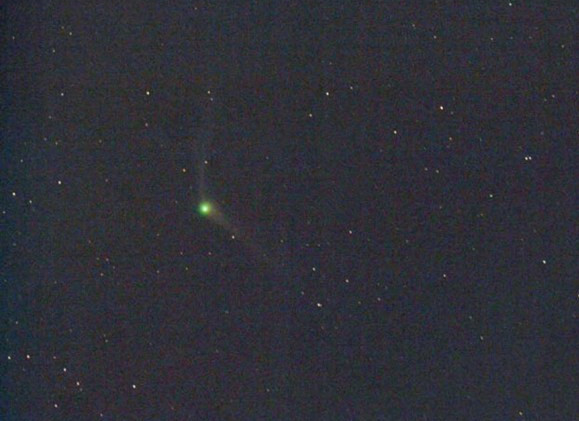Admire the culmination of Catalina Comet in the new year
What's more interesting than welcoming 2016 with a unique astronomical phenomenon?
Discovered on October 31, 2013, US10 comet C (Catalina) arrived at the appropriate position to be observed from now until January 2016. With a binocular or small telescope (or even the naked eye if conditions are ideal), you can observe this comet at dawn the next day.

You can observe this phenomenon with the naked eye.
Catalina is a comet whose starting point is the Oort Cloud at the outer edge of the Solar System. It reached a point on the orbit around its Sun on November 15. At that time, we could not observe because it was quite fuzzy and covered by sunlight when it was too close. It is currently on the way to move away from the Sun and now in a completely observable position from the Earth.
Unlike meteor showers that occur periodically or half-way eclipses, eclipses partly occur relatively frequently, observing a comet with the naked eye through amateur telescopes is always an interesting thing. People love the phenomenon of the sky, especially when it's a comet with a tail .
Of course, most comets create a tail when they move close to the Sun, but you don't always have the opportunity to observe a comet's tail with your eyes through simple, many tools. A comet through an amateur telescope only shows up as a bright dot or a very short and dim light.With Catalina comet, you will even be able to see . two tails.
The picture below was taken through a telescope by photographer Chris Schur in Arizona (USA) on November 22 in a 90-second exposure mode, showing that comets have two tails that form a very wide angle. The green you see is the color of carbon compounds that glow under the influence of UV radiation from the Sun. Of course, with the naked eye or simple tools you will hardly see this color.

Catalina is a comet whose starting point is the Oort Cloud at the outer edge of the Solar System.
As expected, this comet can be observed throughout December this year until January 2016. The appropriate observation time will be at dawn, before dawn - preferably between 5 and 6pm, just before morning . Since the comet is moving fast, its position will be a little different every day, but basically during the ideal time to observe, it is always located in the eastern sky, slightly bent to the Southeast, near Venus's position (Venus is the brightest celestial body at dawn this time so you will be very recognizable). Determining the position of the comet is quite difficult because it is not clear enough to get out immediately with the naked eye even at the best times and conditions, please rely on the images below to compare. compare its position with Venus and the horizon in each stage (these are simulated images taken from Stellarium software)

Catalina comet location before the Sun rises on December 7, 2015.

Catalina comet location before the Sun rises on December 8, 2015.
Above is an image showing the position of the comet about 30 to 45 minutes before the Sun rises in the last two days of December 7 and December 8. This is the brightest expected time for comets, which can be seen with the naked eye. But of course that only happens in places with ideal weather conditions, but basically you still need binoculars, telescopes or camera lenses with high optical magnification. Be aware of the location where you can observe the least pollution possible and keep away from artificial light. Finding a target object with telescopes or binoculars seems difficult. So if you don't have enough experience with patience and luck, you can wait until dawn on January 1, 2016 - that is the right time for us to welcome the new year.
As the image below shows, in the morning of January 1, 2016 (about 5am) , Comet Catalina will be right next to Acturus - a very bright star of the Bootes constellation, so you will have a chance Very good to find it. Aim the lens straight towards Star Acturus (define this star because of its relative position with the Moon and the horizon as shown below if you are not experienced in identifying constellations. This is a throne. Bright stars are easy to recognize if your place is cloudless. For scanning lenses around a small area in the Acturus star region, you will have many opportunities to find Catalina comets.

We can observe this comet throughout December this year until January 2016.
Another small note is that due to deviations in many Vietnamese documents, many people mistakenly believe that comets are a long running light like a meteor. It is wrong , by amateur observations in a short time, you will only see it as a small streak even through telescopes and it seems to stand still without moving due to the change of perspective at about The way from comet to us is very slow.
This will be your last chance to observe such a clear comet until Christmas 2018, when the comet 46P / Wirtanen will approach and can be observed in the sky.
- McNaught - the brightest comet in the past 30 years
- The ISON comet can be observed with the naked eye
- The new comet is approaching the sun
- Video: Comet hit the sun
- Century comets
- In 2013, twice admired the lunar eclipse
- Comet detection is the brightest century
- We are about to see two beautiful meteor shower in 12/2018
- Comet is brighter than the full moon visiting Earth in 2013
- Comet ISON only has dust left
- Comet near Mars on sight
- The comet of the century will not light
 Van Allen's belt and evidence that the Apollo 11 mission to the Moon was myth
Van Allen's belt and evidence that the Apollo 11 mission to the Moon was myth The levels of civilization in the universe (Kardashev scale)
The levels of civilization in the universe (Kardashev scale) Today Mars, the sun and the Earth are aligned
Today Mars, the sun and the Earth are aligned The Amazon owner announced a secret plan to build a space base for thousands of people
The Amazon owner announced a secret plan to build a space base for thousands of people 'Halloween' comet ATLAS melts as it approaches the Sun
'Halloween' comet ATLAS melts as it approaches the Sun  Halloween Object Suddenly Loses Its 'Heart' Before Earthlings' Eyes
Halloween Object Suddenly Loses Its 'Heart' Before Earthlings' Eyes  Rare mirage of comet's second tail as it approaches Earth
Rare mirage of comet's second tail as it approaches Earth  Another comet is about to shine brighter than Venus in the sky
Another comet is about to shine brighter than Venus in the sky  Bright Comet Tsuchinshan-ATLAS to Be Visible to the Naked Eye This Weekend
Bright Comet Tsuchinshan-ATLAS to Be Visible to the Naked Eye This Weekend  The 'devil comet' had its tail ripped off by a solar storm
The 'devil comet' had its tail ripped off by a solar storm 